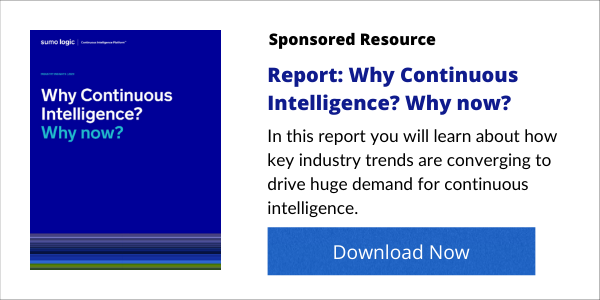
Continuous Intelligence platforms leveraging multiple data sources can surface performance issues immediately, whenever they emerge.
Once upon a time, IT operations teams could get away with taking hours or even days to identify and resolve performance issues in their on-prem data centers.
For companies building cloud-native applications as part of their digital transformation efforts, those days are gone. Modern, cloud-native applications powering today’s digital experiences are complex software environments that change constantly. To ensure their reliability and security, developers and operations professionals need real-time analytics and insights to monitor, troubleshoot, and address security threats to ensure the digital experiences remain available, performant, and secure.

That’s why Continuous Intelligence has become the cornerstone of modern IT functions, migrating workloads to the cloud, and building and operating revenue-generating, cloud-native applications. Here’s a primer on what Continuous Intelligence means, why it’s so critical in modern environments and how to add Continuous Intelligence to your team’s management strategy.
The challenges of modern performance management
There are two main reasons why IT organizations need Continuous Intelligence: very high digital experience user expectations and very complex cloud-native application environments.
Steep user expectations
The first stems from the steep performance expectations of today’s employees, customers, and other users. Consider data points such as:
- 40 percent of users will abandon a website that takes longer than three seconds to load.
- 53 percent of users will abandon a mobile app that fails to load in three seconds.
- IoT devices and applications typically require latency rates no higher than 50 milliseconds and sometimes as low as 10 milliseconds.
- Availability rates above 99.1 percent have become the norm in the modern cloud.
The list could go on, but the point is hopefully clear enough: the margin of error for meeting modern user expectations is exceedingly thin. In some cases, you have just fractions of a second to identify and fix a problem before it turns into a critical application or service disruption.
IT environment complexity
Meanwhile, IT environments have grown so much more complex over the past decade that managing performance issues is considerably more difficult than it once was.
If you’re a modern organization today, you operate a microservices application architecture that runs each application’s components inside containers. These containers are managed by orchestration services like AWS EKS or Kubernetes. They are hosted in a public cloud (e.g., AWS, Azure, or Google Cloud), where you also have an object storage service that houses your application’s data. There are dozens of layers and moving pieces within a stack like this, and they all interact with and depend on one another in complex ways. Since each of these layers represents a level of abstraction given they are operating in virtualized environments with automated processes, visibility in the environment is very difficult. The benefits here are more flexibility and more scalability for those applications, as they can scale up to meet customer demand quickly.

Compare that to the type of environment you might have run a decade ago. Your application was almost certainly a monolith and could well have been running on bare-metal servers. Maybe you used virtual machines, but even that would have been considered complex by the standards of the time. Ten years ago, almost no one was using containers, Kubernetes was just a random Greek word, and cloud computing was considered state of the art, not the de facto way to deploy infrastructure. Making any change to an application meant taking the entire app out of service, and scaling up meant buying bigger hardware.
From the perspective of performance management, greater complexity poses a substantial challenge because it makes it harder to pinpoint the root cause of problems. If an application’s performance starts degrading, is the root cause in the application code? If so, which specific microservice needs to be fixed? Or does the issue instead lie within one of the various parts of your Kubernetes environment? Maybe it’s a problem with a virtual server, in which case it could be an issue triggered by one of your configurations or a problem your cloud provider has to solve.
Understanding the issues around problems like this is difficult enough in circumstances where speed and agility are not a factor. But, when you’re operating a real-time, digital service that’s driving company revenue, the challenge to problem-solve quickly can be overwhelming given the high stakes in end-user expectations and the desire not to see your brand reputation negatively impacted.
See Also: Continuous Intelligence Insights
Solving the modern performance conundrum
How can teams cope with the two-fold performance management challenge described above?
Clearly, the answer is not to keep using the same monitoring and application performance management (APM) tools and methods they have relied on in on-prem client-server or 3 tier environments. They were not designed to understand modern, distributed applications running in the cloud or to deliver true real-time insights from streaming machine data. No matter how many monitoring rules you write or how many agents you deploy, they’re not going to give you the visibility you need in ephemeral, automated, and virtualized application environments.
Instead, teams must turn to AI-enabled APM solutions that enable real-time data collection and processing. Real-time analytics means the ability to identify performance issues immediately – not minutes or hours after an anomaly or a problematic pattern emerges.
Just as important, modern log analytics tools must be able to use AI to identify root causes in real time. If you can only find out that an issue exists in real time, but you can’t determine its source that quickly, you haven’t achieved much.

Continuous Intelligence as the key to modern IT operations
However, even having multiple AI-enabled tools for monitoring and troubleshooting your applications in real-time can slow you down. That’s because different tools don’t talk to each other, and cross-correlating between data types – essential for faster insights to remediation — is impeded. Continuous Intelligence is an approach in which monitoring, troubleshooting, and threat identification are enabled through a single platform that captures metrics, logs, traces, and events, transforming them into real-time analytics and insights that can also be correlated for situational awareness to help solve issues faster and accurately.
By leveraging multiple data sources – application and infrastructure logs, performance metrics, distributed traces, and even possibly data like logs from Continuous Integration / Continuous Deployment tools – Continuous Intelligence platforms surface performance issues immediately, whenever they emerge. They also help your engineers understand the root cause of problems instantaneously, no matter how complex your environment is.
With this data, you can make changes to fix problems faster. This data can also help deal with problems proactively by spotting where slow performance exists before they affect customer experience. Over time, this Continuous Intelligence data can also tell you about customer experience patterns leading to insights to improve your digital service offering with new features and help business leaders track key business performance and risk indicators in real-time.
Conclusion
If your software and infrastructure stacks haven’t changed much since circa 2010, you may be able to get by using traditional IT monitoring and APM methods.
But if you’re like most modern organizations, the shift to cloud and modern application architectures means your technology environment looks nothing like it did a decade ago. At the same time, your digital experience users expect much higher levels of availability and performance than they did in the past.
To cope in the face of both of these challenges, you need Continuous Intelligence.
Learn more about Sumo Logic’s platform, visit SumoLogic.com






